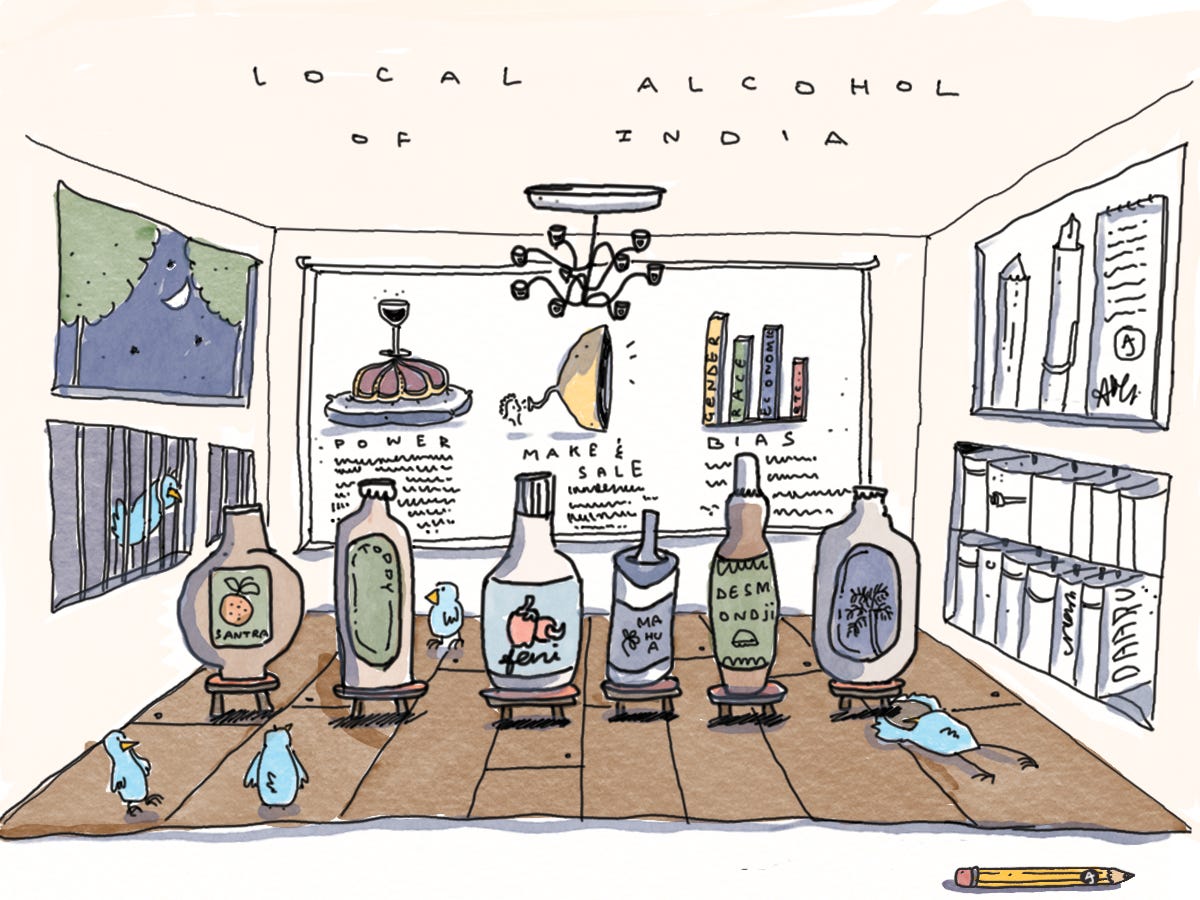Perumal Murugan, in a powerful scene from his Tamil novel “Seasons of the Palm” (2000), takes us right up into the fronds of a tall male palm tree on a moonlit night. Through toddy, Murugan plays with height and hierarchy, with drunkenness and dreams, with hunger and shame, with vulnerability and courage, with audacity and fear, with freedom and bondage. I must thank Sujata Shukla for bringing this incredible book to our attention.
Shorty - the protagonist - an “untouchable” shepherd, has to use his loincloth to help himself scale the tree. He has to watch out for the rough bark, the stinging prickly thorns, and choose a strong frond to perch his nakedness on.
Once he reaches the top, the feeling of being “above” the landscape emboldens him… “He wants to stretch out his hands and fly. Float on the night air, slide down a moonbeam, swim the expanse of the sky…” This audacity is underscored by the liquid courage he gains by drinking the “clear, light toddy” that is neither sour nor cloyingly sweet. Suddenly his master’s son - Selvan - becomes an unthreatening “stringy crane”, a “garden lizard”, a “crow like beaky bird” , “a sniffing graveyard dog”- someone at whom Shorty can hoot and laugh at.
We can almost smell, taste and hear the toddy as it gurgles and foams over in the tiny earthen pots that are tied in the tree by the professional toddy tapper, Kandan. Murugan describes the frothing alcohol drops as “speckled and bright, like a cat’s eye”. Shorty has to blow off the ants and insects from the surface of the liquid before he can drink it.
In desperation to have his first sip of toddy, Selvan, overcomes his “disgust” and agrees to break caste rules to savour toddy from the same tin pail used by Shorty, and their pet dog Poochi. He however, keeps trying to reassert his power by cursing Shorty, throwing stones at him, and threatening to inform his father and the toddy tapper of Shorty’s activities.
For the 16th meeting of the Yayavr Food Reader’s Club, which took place on January 30, 2024, thirty of us pondered on the role of power and its relationship with alcohol. Participants shared personal stories on the whatsapp group, and resources via google classroom.
Nikita Biswal’s essay “The Secret Era of Bombay's Aunty Bars” (2021), an excerpt from the Tamil novel “Seasons of the Palm” by Perumal Murugan where the protagonist scales a palm tree and drinks toddy (2000), and Sumanta Banerjee’s essay “Alcoholics Unanimous: A Historical Tale of the Fraternity of Aficionados of Alcohol in Calcutta”(2016) formed a launchpad for our discussion. The readings and the session were curated by 3 veteran members of the club - Sujata Shukla, Kartik Banota and Manoshi Nath.
Through an online animated discussion, three broad themes emerged:
Role of the Indian State and Alcohol Consumption
How do state policies try to control the manufacture, distribution, sale and consumption of alcohol in India? What communities are allowed to store and collect the raw ingredients (example mahua flowers) that can be used to make alcohol? What is the role of state taxes, licenses and permits in alcohol circulation - especially liquors prepared by marginalised communities? How is the Criminalization of Tribals Act related to the production and consumption of alcohol?
Jatin observed that many of the directives in the constitution grappled with the idea of an “Ideal Indian'' - especially in trying to articulate a newly formed postcolonial identity. Lakshmi shared the section on prohibition in Bombay in “A People’s Constitution: The Everyday Life of Law in the Indian Republic” by Rohit De (2018)
Anand Ganapathy reminded us of how ministers such as Morarji Desai who staunchly supported prohibition were lampooned by R.K. Lakshman in his newspaper cartoons.
Culture - Nature - Commerce
Elizabeth Yorke shared her notes from a field trip from Peddamaduru, Telangana, led by Dr. Sai Bhaskar Reddy, where daily wage farm workers were paid with “toddy”. She added that the local labourers underscored the role that ants, monkeys and crows played in the propagation of palm trees, and were aware of the differences in yield and taste of the toddy between male and female trees. Such knowledge is slowly dying as fewer families tap the sap and prepare toddy each passing season.
Kartik Banota said that tribal communities may not have the resources - large scale equipment, capital and political power - to buy licences to compete with commercially produced alcohol. Moreover certain GI tags may backfire, when communities are not able to standardise their processes. Kartik also mentioned the “pehli dhaar” - the first stream of local alcohol that is concentrated with methanol and is discarded by the tribals who produce it. He said they use the “blue flame” test to see if the alcohol is safe to consume.
Sumanth shared instances of deities and temples where offerings of local liquor, beedis and chaklis are made. Smrti reminded us of the Tamil short story “The Final Abode of Maadan” by Jeyamohan where the deity Sudalai Maadasami is enraged that the villagers have stopped offering him toddy, pork curry, chickens and goats.
Power and Access
Manoshi, Sulipta and Vanita pointed out the gender bias in the consumption of alcohol in public spaces, and how many journalistic articles/ headlines often hold the “drunk woman” responsible.
Madhu brought up a more subtle type of power, where access to alcohol is controlled or granted with a patronising hand. We shared how women of a certain generation still don’t feel comfortable drinking alone in public, or even sitting on a bar stool.
This discussion continues on our social media channels, with participants sharing fascinating reads every week. To join our upcoming reader’s club sessions, and to contribute to this zine, follow us here.




